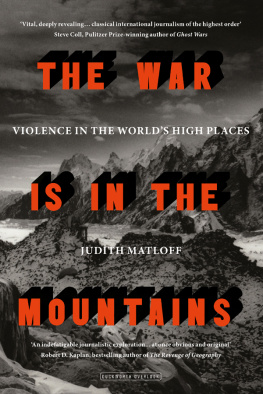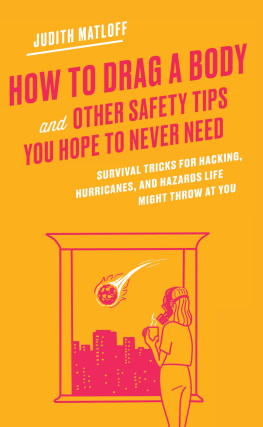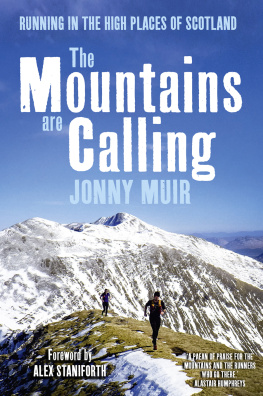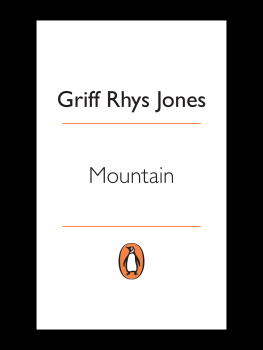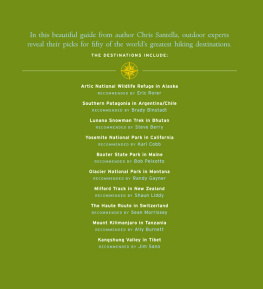Judith Matloff - The War Is in the Mountains: Violence in the Worlds High Places
Here you can read online Judith Matloff - The War Is in the Mountains: Violence in the Worlds High Places full text of the book (entire story) in english for free. Download pdf and epub, get meaning, cover and reviews about this ebook. year: 2017, publisher: Duckworth Overlook, genre: Politics. Description of the work, (preface) as well as reviews are available. Best literature library LitArk.com created for fans of good reading and offers a wide selection of genres:
Romance novel
Science fiction
Adventure
Detective
Science
History
Home and family
Prose
Art
Politics
Computer
Non-fiction
Religion
Business
Children
Humor
Choose a favorite category and find really read worthwhile books. Enjoy immersion in the world of imagination, feel the emotions of the characters or learn something new for yourself, make an fascinating discovery.
- Book:The War Is in the Mountains: Violence in the Worlds High Places
- Author:
- Publisher:Duckworth Overlook
- Genre:
- Year:2017
- Rating:3 / 5
- Favourites:Add to favourites
- Your mark:
- 60
- 1
- 2
- 3
- 4
- 5
The War Is in the Mountains: Violence in the Worlds High Places: summary, description and annotation
We offer to read an annotation, description, summary or preface (depends on what the author of the book "The War Is in the Mountains: Violence in the Worlds High Places" wrote himself). If you haven't found the necessary information about the book — write in the comments, we will try to find it.
The War Is in the Mountains: Violence in the Worlds High Places — read online for free the complete book (whole text) full work
Below is the text of the book, divided by pages. System saving the place of the last page read, allows you to conveniently read the book "The War Is in the Mountains: Violence in the Worlds High Places" online for free, without having to search again every time where you left off. Put a bookmark, and you can go to the page where you finished reading at any time.
Font size:
Interval:
Bookmark:
Impressive and necessary Matloff approaches her topic with a magic combination of wisdom and empathy, and it is impossible to not be moved
Booklist, starred review
This trip to some very different corners of the globe is recounted in clear, visceral language Matloffs investigation is a worthy read for foreign affairs and anthropology buffs alike
Publishers Weekly, starred review
A sobering account of why mountainous regions often engender violence a tightly focused study
Kirkus Reviews
Matloffs book is an indefatigable journalistic exploration of how mountains shape, sustain, and even determine war and culture around the world. Her argument, which her reporting makes undeniable, is at once obvious and original
Robert D. Kaplan, bestselling author of The Revenge of Geography
A vital, deeply revealing book of political travelogue and intrepid correspondence. Matloff is the ideal witness learned, dogged, skeptical, but always listening out for new and credible voices. This is classical international journalism of the highest order
Steve Coll, Pulitzer Prize-winning author of Ghost Wars
Through thoughtful vignettes, [Matloff] weaves personal narratives alongside relevant historical and present-day circumstances to relate regional stories that consistently refer to and affirm the global tale she seeks to tell
Library Journal
Judith Matloffs book is a political geography of mountains, once the haunt of witches, now in many parts of the world strongholds of outlaws and rebels, told with a sense of drama by someone who has clearly done her fieldwork
Yi-Fu Tuan, author of Romantic Geography
Matloff a brave, engaging, keenly observant guide rides shuddering buses, boards decrepit helicopters, and hikes through mud and checkpoints in pursuit of answers and solutions reveals the rich, surprising and perplexing life of places too often diminished by the flat imagery of war
Sheri Fink, Pulitzer Prize-winning journalist and author of Five Days at Memorial and War Hospital
Vistas, vainglory, vengeance and violence mark Judith Matloffs engaging voyage across mountainous terrains. She reports with empathy on religious charities, anthropologists, guerrillas, and state armies all attempting to pacify some of the worlds least governed spaces
David D. Laitin, Professor of Political Science at Stanford University and author of Nations, States and Violence
A globe-hopping, more-often-than-not crushing investigation into mountain mayhem chromatic stories, which cant help but be chromatic as they are smeared blood red, from the Sierra Madre, the Caucasus, Jammu and Kashmir, the Himalayas, and the Andes
Christian Science Monitor
IS IN THE
MOUNTAINS
VIOLENCE IN THE WORLDS HIGH PLACES
JUDITH MATLOFF

To Anton and John
And to every mountain person who goes unheard
Here place and people seem to be
A world apart, alone;
Cut off from men by spate and scree
Henrik Ibsen, Mountain Life (1859)

The mountain seems no more a soulless thing,
But rather as a shape of ancient fear,
In darkness and the winds of Chaos born
George Sterling, Night on the Mountain (1914)
I met Jean Lassalle and Mario Conejo in a ballroom in the Pyrenees, at a concert of Andean pipe music in the baroque town hall of Pau, a city with a fairy-tale castle surrounded by majestic peaks. They were an incongruous pair, so I was surprised when they called each other brother. Lassalle wore a suit over a cuffed shirt, the uniform of the politician; a French parliamentarian, he represents shepherds in the region. At six feet seven inches and with an impressively craggy nose, he looms like a human cliff in business attire. Conejo, also an elected official, is at least two feet shorter, with a waist-length braid. He wore a bowler hat, and his white tunic identified him as an Indian of the Ecuador highlands, where he serves as mayor of the town of Otovalo. Pachamama, he called the Andes. Mother Earth.
Despite the dramatic height differencethe indigenous mans face just barely reached his friends chestthey professed to see eye to eye. Mountain people instantly understand each other, explained Lassalle. We dont view things like folks from the plains. Conejo gave a solemn nod, and they embraced fraternally. They addressed each other in labored Spanish, a second language for both.
Lassalle heads the World Mountain People Association (WMPA) a network of proud highlanders from seventy countries who meet on scenic ascents every year to discuss their commonalities and their grievances. The association was born out of a global forum organized by UNESCO in June 2000. Some nine hundred mountain dwellers from around the planet gathered in the French Alpine town of Chambry with a common mission: to pursue equitable and sustainable development and the continuity of mountain identity. The association survives on financing from French and Swiss authorities, organizations of native mountain groups, foundations, and private partners. Larger fears underlie the highlanders stated concernsfears about identity, and survival. Many members, like the Berbers and the Basques, aspire to self-determination.
WMPA meetings rotate among the worlds major mountain ranges, so that everyone can visit each others ancient communities. The gatherings call to mind the pointed multiculturalism of a Benetton ad, except the diversity here is genuine and unself-conscious. Turbaned Tuaregs and Bolivian coca growers in sandals sit alongside Sherpas from Nepal, all eagerly chatting away while sampling local sheep-milk delicacies. Much of the conversation, facilitated by teams of translators, focuses on shared concerns: How to gain control over the metals and water embedded in their traditional burial grounds? How, also, to prevent tourists from spoiling ancient pastures?
Sitting in this peaceful place, witness to the brotherly love flowing between the worlds mountain peoples, and mellowed by the ethereal yet earthy pipe music, it was easy to forget why I was there: to report on the prevalence of violence in mountainous regions. Mountains cover one-fourth of the earths surface and account for only 10 percent of its population. Yet they host a strikingly disproportionate share of its clashes. A 1999 United Nations report revealed that twenty-three of the twenty-seven major armed conflicts in the world were being fought in mountain areas, and that ratio remains roughly true today. The Sierra Madre, Afghanistan, the Caucasusthese and many other regions are plagued by drug violence, uprisings, Islamist extremists, and other dangers nurtured at high altitude.
The WMPA, for its part, focuses not on violence but on addressing the many challenges of life in the highlands. The organization is based in Oloron-Sainte-Marie, the picturesque stone town where Lassalles family was, at the time that I met him, encouraging shepherds to mobilize against the importation of Slovenian bears to ancient grazing lands. In recent years the central government had relocated two of the creatures to this mountainous corner, and now it was rumored that more were coming. The shepherds were concerned that the bears would decimate their flocks. The protests included blocking roads and planting broken glass in honey pots to injure marauding bears.
Font size:
Interval:
Bookmark:
Similar books «The War Is in the Mountains: Violence in the Worlds High Places»
Look at similar books to The War Is in the Mountains: Violence in the Worlds High Places. We have selected literature similar in name and meaning in the hope of providing readers with more options to find new, interesting, not yet read works.
Discussion, reviews of the book The War Is in the Mountains: Violence in the Worlds High Places and just readers' own opinions. Leave your comments, write what you think about the work, its meaning or the main characters. Specify what exactly you liked and what you didn't like, and why you think so.

